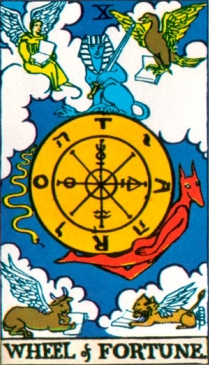
The Wheel of Fortune’s number is 10 which puts it as close to the center of the major arcana cards as you can get, assuming The Fool, 0, is at the beginning, so it signifies a turning point or balance point. The number 10 is also the beginning of the next series of digits after 0-9 (The Fool through The Hermit), so it can be seen as the beginning of a new cycle. This cycle can be either “better” or “worse” than the one before it, but it is always a step up in complexity and challenge.
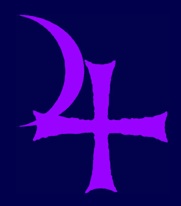 Jupiter is the planet assigned to the Wheel of Fortune. As the largest planet in the solar system, it is the planet of expansion, which is what the Wheel does—it expands not only our outlook, but our options. Astrologers also call it the Greater Benefic, or bringer of good fortune, with Venus, The Empress, being the Lesser Benefic.
Jupiter is the planet assigned to the Wheel of Fortune. As the largest planet in the solar system, it is the planet of expansion, which is what the Wheel does—it expands not only our outlook, but our options. Astrologers also call it the Greater Benefic, or bringer of good fortune, with Venus, The Empress, being the Lesser Benefic.
 Kaph, or Kaf, is its Hebrew letter. Its symbol is the palm, or open hand. The mystical interpretation of this letter is potential, which holds the possibility of that potential to manifest in the material world, in other words, serpent power bringing an event or thing into physical existence. This translates into
Kaph, or Kaf, is its Hebrew letter. Its symbol is the palm, or open hand. The mystical interpretation of this letter is potential, which holds the possibility of that potential to manifest in the material world, in other words, serpent power bringing an event or thing into physical existence. This translates into 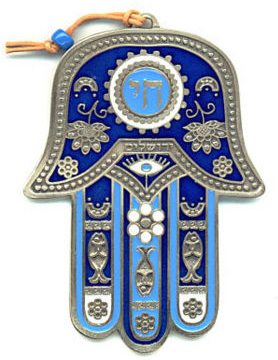
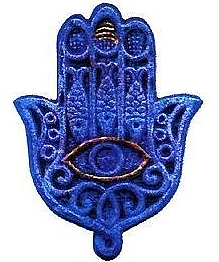
The Rider-Waite-Smith Wheel of Fortune card, shown above, continues the animal imagery of the Marseilles decks. The descending yellow serpent is, of course, the materialization of serpent power from The Chariot, Strength, and The Hermit. The red man-dog ascending from the low point of the Wheel is Anubis, the Greek name for the Egyptian god of death and mummification, who was therefore the one who made rebirth possible. He walked at the head of every ancient Egyptian procession. (Wikipedia, Anubis entry) The blue sphinx at the apex is our True Self, the part of us that is always in contact with the life force or serpent power and understands the riddles of the universe.
The wheel has eight spokes which remind us of the four turning points or the year, Winter Solstice, Spring Equinox, Summer Solstice, and Fall Equinox; plus their four midpoints, Imbolc (Groundhogs Day, February 2), Beltane, (May Day, May 1), Lughnasadh (August 2), and Samhain (Halloween, October 31). Interspersed among the spokes are the letters R-O-T-A which can be rearranged into ROTA TAROT ORAT TORA ATOR. ROTA, of course means wheel, ORAT is Latin for speaks, the TORA(H) is the first five books of the Hebrew bible, and ATOR is an old Latin form of the name of the Egyptian goddess Hathor. The whole thing translates as “The Wheel of Tarot Speaks the Law of Hathor (The Law of Nature).” (Paul Foster Case, The Tarot, a Key to the Wisdom of the Ages). In between the letters R-O-T-A are the letters Yod Heh Vav Heh, the Hebrew name of God, which is their version of the power that runs the universe, or serpent power. At the four corners are an angel, an eagle, a lion, and a bull, which are the forms of Aquarius, Scorpio, Leo, and Taurus, the four fixed signs of the zodiac. They tell us that the universe has a set meaning and purpose, and the seeming randomness of the Wheel of Fortune turns within that meaning and purpose.
My favorite version of this card is this fairy-steam-punk image by angiechow.
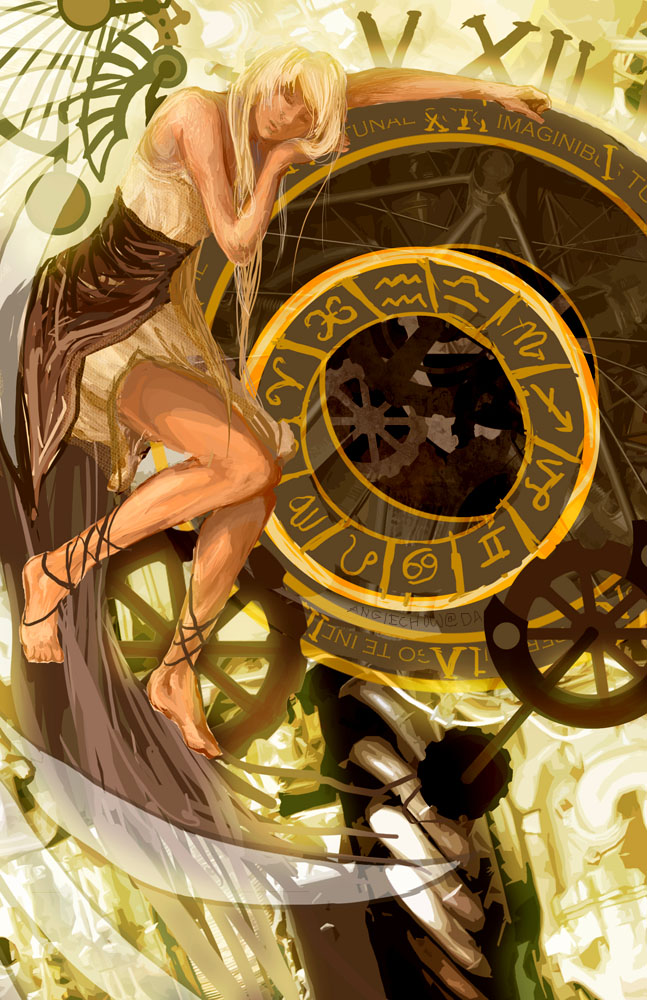
It shows a fairy, or Lady Luck, leaning on the Wheel, which is turned by interconnecting wheels within wheels within wheels. She can nudge it one way or the other if she chooses, but look closely and you will see that all those wheels are ultimately geared into the great spiral of life, or serpent power, which has its own agenda.
In a reading, the Wheel of Fortune can be either fortunate or unfortunate, depending on whether it is upright or reversed, its position in the spread, and the cards around it. It tells the reader that things have happened, are happening, or are about to happen in the querent’s life. Or, if the card is reversed, they may be stuck in a rut. It may signify the end of a cycle, a turning point, and a time to reap the rewards or misfortunes of past. It can also mean a future that is undetermined, awaiting either effort in one direction or another from the seeker or some event that is yet to come. And sometimes shit just happens, and this card warns us of that as well. I can’t believe that all those people in the Haiti, Chili, and Japan earthquakes were supposed to die right then, they died because they were in the wrong place at the wrong time, what I would call true bad luck, not karma.
In the hero’s journey, The Wheel of Fortune is usually some unexpected event that brings about a meeting with an Ally, an Enemy, or an Ordeal. It can also be the Herald, or turn of events that begins the adventure.
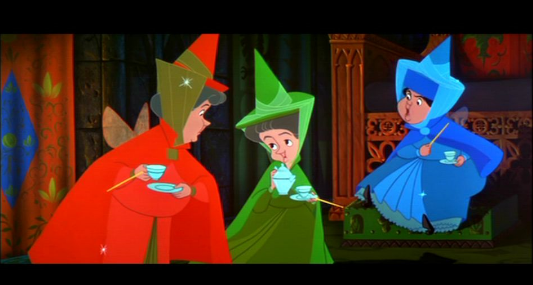
The story of Sleeping Beauty is a perfect example of this. It begins with the three good fairies in the process of giving the baby princess the traits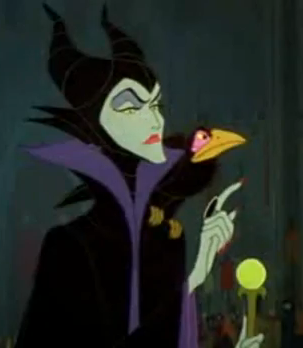
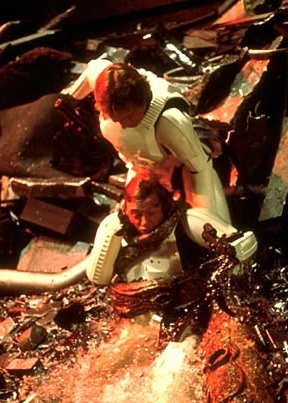 The Wheel of Fortune as an unexpected event that brings about an Ordeal is behind the horrible surprise of a tentacled monster in the trash masher of the Death Star. It grabs Luke and drags him to a wet and dirty death. Right when we’re sure he’s dead, our hero erupts, alive and well, out of the watery goo. He has gained strength and experience that he will need later on.
The Wheel of Fortune as an unexpected event that brings about an Ordeal is behind the horrible surprise of a tentacled monster in the trash masher of the Death Star. It grabs Luke and drags him to a wet and dirty death. Right when we’re sure he’s dead, our hero erupts, alive and well, out of the watery goo. He has gained strength and experience that he will need later on.
The Wheel is always turning, presenting us with new challenges, pleasures, and points of view.

